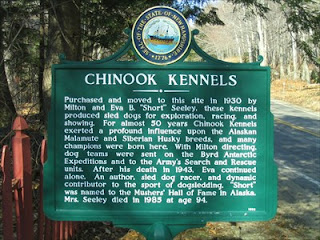When the Conway Public Library reopens after the Thanksgiving holiday, you will be able to see a newly installed artwork that was painted, donated and installed by the artist Ernest O. Brown of Conway, New Hampshire.
Shown here with the artist on the left and Library Director David Smolen on the right, the painting entitled "Postern Gate No. 4" is acrylic on canvas and 48 x 48 inches square. The location on the stairway allows a great opportunity to view the painting from afar to appreciate the fine atmospheric and linear perspective and up close where you can examine the incredibly detailed brushwork. Mr. Brown has provided a label to help explain the painting (click on the image to enlarge it).
Mr. Brown points out that the subject of the painting is on the West Side Road in front of the Hale House (looking east). While he acknowledges that the landscape in the painting is "artistic license" the layout and details of the posts as seen in the photo below are quite accurate.
Mr. Brown presents each of his granite posts as a unique palimpsest with a layered history. He demonstrates a miraculous ability to capture shadows, light, reflections of and on the granite posts as well as the lichen, rust and water stains, and subtle variations of color in the granite itself due to the surface color and the way the light hits the coarse grain texture of the granite's component parts - quartz, feldspar and mica.
Here is a view of the granite posts from the street looking towards the west with the historic Hale Farm House beyond.
Here is a view of the five posts from above showing how they are arranged.
It is quite probable that posts were originally used as a "squeeze stile" type livestock gate that allowed people to pass freely but which livestock avoided pasing through. Here you can see holes for fencing and a metal ring attached to one of the posts.
According to his label for the painting, stone posts are a common subject for Mr. Brown. They are everywhere in our landscape. They reflect a Yankee resourcefulness of "making something out of nothin." He explains that "The farmer/landowner usually was the "quarryman." The evidence for how these posts were made can be seen in the painting.
The five short horizontal lines seen in the post on the left are tool marks left by the drilling and splitting of the stone.
A hammer and star tipped bit was used to drill a series of holes about three inches deep along the line you wanted to split the stone.
Then a pair of "feathers" was inserted into the drill holes and a wedge or plug was hammered between the feathers. The pictures below illustrate the process.
If all works out well the stone splits along a relatively straight line. The stones were fashioned into foundation blocks for cellar holes, cemetery fence walls, door stoops, hearth stones, and so on.
A few more stories about local quarry work can be found at these links
here and
here.
As Mr. Brown points out the "trimmings" were used as posts.
However, things did not always work out for the quarryman. Throughout the woods, you can find examples where they started to quarry a boulder...
... and for some reason, they abandoned their work...
...and left the drilled holes filled with the feathers and wedges that rusted in place over time.
Mr. Brown explains the title of the painting "Postern Gate..."
comes from an architectural term for a small gate, "usually one person wide, set in a
castle wall to allow leaving or entering a castle, not thru the main
entrance."
In this case the postern gate is opposite the main entrance as identified by the drawbridge and portcullis.
The idea of a postern gate goes way back in military fortifications. One of my favorite examples is the postern gate at the ancient Hittite city of Hattusa in what is now Turkey (the city also has the remains of one of the earliest known buildings built specifically as a library - so that makes me fond of the site as well).
It is a small unassuming gate that can be accessed through a long tunnel or sally port.
Speaking of military history, Mr. Brown says the figure in the painting is "a self portrait of the artist..."
On the day he came to install the painting, he was wearing the hat that can be seen in the painting with the insignia (crossed sabers) of the 9th Calvary in which he served.
As they say in the 9th Calvary "We Can, We Will" and in this case Mr. Brown did!
Thanks!




























































